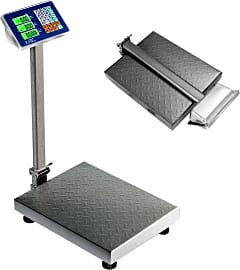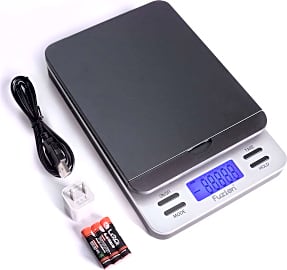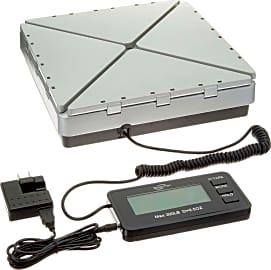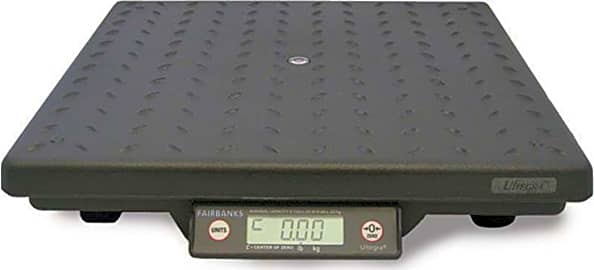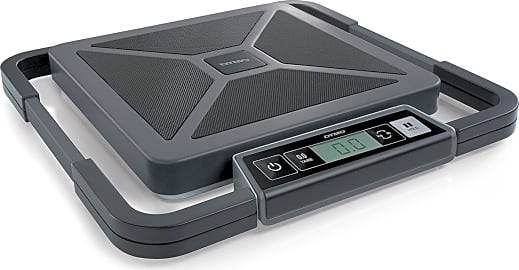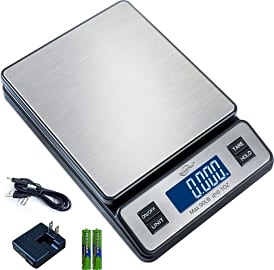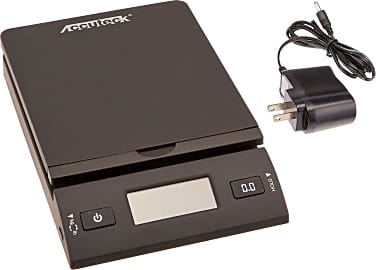The 10 Best Postal Scales

This wiki has been updated 43 times since it was first published in August of 2015. Whether you work for a shipping company, distribution warehouse, or small business that mails packages on a regular basis, you can ensure accurate postage rate calculations using one of these handy postal scales. Many of our options are capable of running on batteries, USB cables, and/or conventional AC power, with the capacity for weighing anything from letters to 400-pound boxes. When users buy our independently chosen editorial picks, we may earn commissions to help fund the Wiki.
Editor's Notes
April 01, 2021:
As mentioned by the author of our February 22, 2020 editor’s note for this page, technology in this space has been in a rather static state for some time now. Considering that, and the fact that all of our previous picks were still presenting excellent utility and good availability, we managed to make it all the way through this update without… well, doing any updating. Believing that the last editor for this page did a good job of including models of varied weight capacities – with some, like the Weighmax Transformer and Accuteck ShipPro even offering 10-year warranties – we decided to leave this list alone, at least until the next time it comes due for an update.
Options in this category are suitable for all sorts of parcels, but if you’re interested in taking precise, lightweight measurements, then you might have better luck with our rankings for gram scales and milligram scales.
February 22, 2020:
This list didn’t need a lot of updating, and removing some older models here wouldn’t make much sense since the technological quality of digital scales has pretty much remained the same for the past 10 years. They’re as accurate today as they were 10 years ago, and they come with the same features, like ‘hold’ and ‘tare’ functions. What I did during this update was remove a few of the less ‘precise’ scales.
There was a good mix of scales already in the list, ranging from the Zieis Big Top with a 30-lb capacity and the MyWeigh Ultraship rated at 75 lbs, to the some of the more heavyweight options like the Angel USA and Smart Weigh Digital with capacities of around 400 lbs; though I thought the list was missing an ultra-high-capacity scale, so I’ve introduced the Giantex Platform, which has a 660-lb capacity. The Giantex also adds some variety to the list, since it’s a floor-standing model made for those larger shipping boxes and packages, and not a countertop scale.
You’ll notice that scales with higher capacities are generally less precise, with margins of error at around 1oz and higher; by contrast, models that offer capacities of up to 100 lbs should offer precisions of 0.1 (0.00625 lbs) or 0.01 lbs, if you’re measuring in pounds. Most often though, scales, and especially scales with large ranges, usually offer split precisions with lighter parcels being more accurately measured than heavier ones. In light of this, I’ve replaced some of the less precise models. The Smart Weigh Digital had both a lower capacity and less precision than the Giantex Platform that I introduced, so it had to go. I’ve also removed the Ohaus Compact, as well as the Zieis Big Top because of its low capacity – my argument being that you may as well get a scale with a larger capacity and the same level of precision if you can. I’ve introduced the Accutek Black, which offers a split precision of 0.1 oz for weights below 25 lbs, and 0.2 oz. for weight between 25 to 50 lbs; it’s not the most precise scale in the world for heavier parcels, but it’s cheap and simple to operate, and it comes with a generous warranty. I’ve also added the Fuzion Digital to round out the list.
Bearing The Load
The greater the number of load cells with which a scale is equipped, the greater the scale's weight capacity.
Whether you own a large business with a storefront or you sell products over the internet, chances are you're doing a lot of shipping. This requires many trips to your local post office, which is fraught with disturbingly long lines and overpriced shipping rates. The good news is that you can save yourself both time and money by calculating your shipping costs from the comfort of your own home or place of business using a postal scale instead. This can be done before you even think of stepping foot into the post office.
A postal scale is a device that uses an electronic integrated circuit pressure sensor to calculate the exact weight of a package. The weight value is typically displayed on an LCD located on the front of the scale itself. Unlike a conventional bathroom scale that uses a dial, internal spring, and a series of levers to indicate the weight of an object, the postal scale operates a bit differently. Its components consist of an overall structure, which is the part of the device that actually bears the load; a weight indicator, usually represented by the LCD; a load cell, which converts the force of an object into an electrical signal; and a signal conditioner, the electronic component that powers the load cell. The signal conditioner is also responsible for converting the electrical signal into numbers for the scale to display. But how does this work in a step-by-step fashion?
When a package is first placed on the scale, its force of weight is evenly-distributed by a series of underlying pegs underneath the flat surface of the scale's outer structure. Next, the device's internal components apply the force of weight to one end of the unit's load cell, bending that end downward. This action ultimately deforms the scale's strain gauge, which consists of either metal tracks or foil bonded to a printed circuit board. When the foil is strained, the circuit board also stretches. The combination of deformation and stretching allows the strain gauge to convert the force of weight into an electrical signal. What makes this possible? The internal load cell carries a charge, which means its electrical resistance changes when it bends downward. Once the electrical signal has been generated inside the scale, it passes through an analog-to-digital converter and a microchip. The microchip is responsible for interpreting and translating the signal data into a readable format that appears on the scale's LCD.
The load cell helps determine a postal scale's recommended weight capacity. The greater the number of load cells with which a scale is equipped, the greater the scale's weight capacity. It's important to note that while the scale may accommodate a weight greater than what its load cell can bear, its overall level of accuracy is compromised when used beyond its recommended range. That said, to ensure that proper shipping rates are calculated, it is recommended not to exceed a postal scale's load cell rating.
Keeping It Real And Accurate
Ensuring that your device will prevent you from overspending at the post office is an important consideration. There are plenty of useful features common to postal scales that help make that easier and for which you should be on the lookout when considering such an investment. These include a tare function, allowing for zero calibration without adding additional weight; a holding feature, which maintains a previous calculation on the LCD after removing a package from the scale's surface; and the ability for the device to run on both AC and battery power. The hold function is particularly useful when you're stuck weighing large packages that obstruct your view of the scale's LCD. Having several power options makes the scale easy to transport, which comes in handy if part of your business requires a lot of travel when shipping objects.
A scale with an automatic shutoff feature will save additional power and prevent it from wearing down its internal battery when you're on the go. Some postal scales also include built-in audible alerts when an object's weight stabilizes, so you can be sure that you're getting the most accurate reading possible. Look for a scale capable of displaying weights using different metrics, such as grams or kilograms.
It's also important to realize that shipping rates aren't set in stone. Spending a bit more on a scale that can connect to a computer and Wi-Fi will allow it to have access to the latest shipping costs and updates.
A Brief History Of The Postal Scale
Scales have a long history dating as far back as 2000 BCE to an ancient relic found within the Indus River Valley not far from present day Pakistan. It is believed that this early device consisted of a balancing structure that used two plates attached to an overhead beam and central pole. Weight measurements would be taken by placing objects on one plate with rocks on the other until equilibrium was obtained. Balances also had a significant impact on other civilizations, including ancient Egypt.
The use of various electronic attachments for spring scales was introduced as early as the 1940s for improving weight reading accuracy.
Further technological advances leading to the development of the weighing scale appeared by the late 18th century and are largely credited to spring and scale maker Richard Salter. Following R. W. Winfield's 1840 development of the candlestick scale for letters and packages, spring-operated scales became common throughout the United Kingdom. Spring scales were easier to use because their readings could be taken almost immediately without any required balancing.
The use of various electronic attachments for spring scales was introduced as early as the 1940s for improving weight reading accuracy. Load cells also served to improve scale accuracy through the late 20th century when the use of digital scales became more widespread. Today, postal scales are equipped with plenty of high-tech functions, including Wi-Fi access, built-in calibration software, and lightweight designs with various power options to increase portability for the traveling business.


